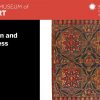The Shamisen in Japanese Art and Music
Tatsu Aoki, shamisen, with curator Kit Brooks
Follow one of Japan’s signature musical instruments, a three-stringed lute called the shamisen, through the many worlds in which it has played a prominent role, from kabuki and puppet theater to the folk music of blind beggar-musicians and the geisha houses of Tokyo’s Yoshiwara district. Explore the transformation in Japanese aesthetics from relaxed and improvisational styles to the more standardized repertoires of later decades by examining woodblock prints, paintings, and photographs, and by listening to three masters of the shamisen perform.
Our guides will be curator Kit Brooks, who specializes in prints and paintings of the Edo and Meiji periods, and musician and filmmaker Tatsu Aoki, who was born into a family of geisha managers in Tokyo and learned their shamisen repertoire before moving to the United States to pursue a career in jazz, film, and experimental music. He will be joined from Tokyo by Nobuto Yamanaka, a specialist in the tsugaru shamisen style developed by Japan’s beggar-musicians, and Chizuru Kineya, a master of the nagauta shamisen music that accompanies kabuki theater.
Tatsu Aoki’s family operated several okiya houses that oversaw the training and booking of geisha in three districts of downtown Tokyo. He joined the performance team in early childhood and continued his musical training there into his early teens, when he was drawn to the Tokyo underground arts movement and began performing experimental new music. After moving to Chicago in 1977, Tatsu Aoki became a leading advocate for the Asian American community there, as well as a prolific composer, filmmaker, educator, recording artist, and sought-after performer on shamisen, taiko, and upright bass. He directs the Chicago Asian American Jazz Festival, Asian Improv aRts Midwest, the Toyoaki Shamisen arts residencies, and the annual Tsukasa Taiko Legacy event at Chicago’s Museum of Contemporary Art. His avant-garde jazz ensemble, the MIYUMI Project, appeared at the Freer Gallery in 2001.
Kit Brooks holds a PhD in Japanese art history from Harvard University (2017) and is The Japan Foundation Assistant Curator of Japanese Art at the Freer and Sackler. Their primary research interests revolve around the reevaluation of “eccentric” artists of the eighteenth century, and the relationship between illustrated books and paintings—particularly the special prints that emulate the visual qualities of other media, such as surimono and takuhanga. Kit has held positions at the British Museum, Harvard Art Museums, and the Children’s Museum in Boston. They curated the exhibition Uncanny Japan: The Art of Yoshitoshi (1839–1892) at the Worcester Art Museum (2015) and cocurated Living Proof: Drawing in 19th-Century Japan at the Pulitzer Arts Foundation (2017–18).
















![Private: [ID: _lB45RXOMsY] Youtube Automatic](https://nezha.pro/wp-content/uploads/2023/01/private-id-lb45rxomsy-youtube-au-100x100.jpg)
![Private: [ID: Dr1pBALc09U] Youtube Automatic](https://nezha.pro/wp-content/uploads/2022/11/private-id-dr1pbalc09u-youtube-a-100x100.jpg)
![[ID: q8mjc_gatNA] Youtube Automatic](https://nezha.pro/wp-content/uploads/2022/11/id-q8mjcgatna-youtube-automatic-100x100.jpg)










![Accessing Your Best Self [Livestream with Coach @Yuri Choi Exclusive Affirmation Workshop]](https://nezha.pro/wp-content/uploads/2022/02/accessing-your-best-self-livestr-100x100.jpg)


